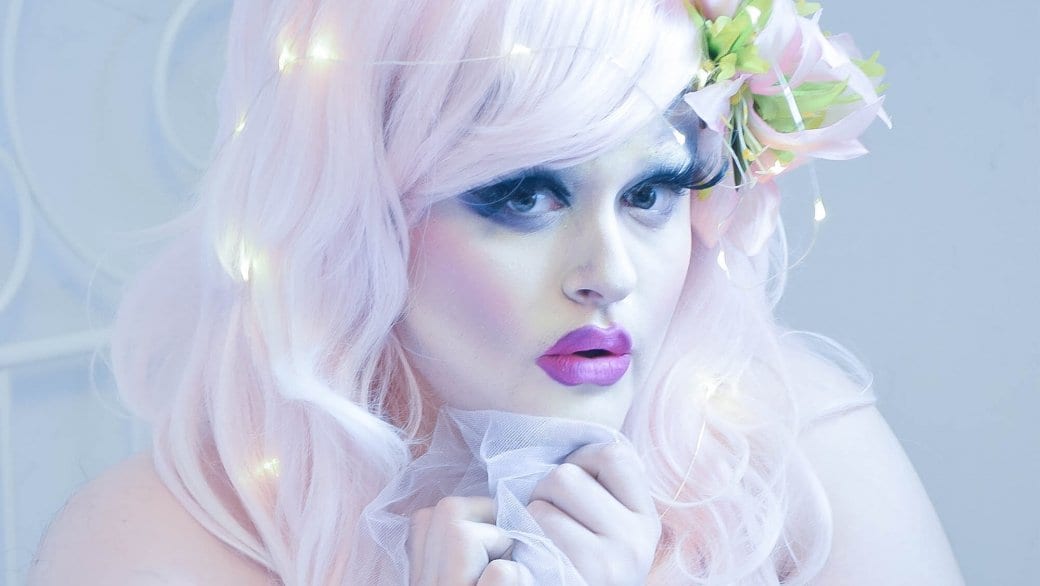It’s October 2015 and all you want is a relaxing — and maybe a little spooky (it is almost Halloween, after all) — night of drag and drinks. So you go out to an event by the drag troupe The House of Filth, called Bad Tuck: A Queerican Horror Story. You poor, poor soul.
Dottie Dangerfield slinks onto the stage. She’s got big hair, a wild expression and thick bands of eye makeup that make her look something like a slow loris. And much like the adorable animal — which is the world’s only venomous primate — she’s not to be trifled with.
She’s not here to just move her lips and arms at you. She starts shoveling ingredients into a blender — random items probably purchased at a dollar store, as well as strange sauces and bits of chicken. Dear god, what is she going to do with that?
You, my dear, hapless audience member, are about to be traumatized.
“[She] force-fed it to somebody on stage and then threw it at the audience,” The House of Filth’s Judy Virago says, reflecting. “She grossed us all out — and it takes a lot to gross me out. We were very proud.”

Dangerfield is an unusual sort of drag queen, and not just because of her penchant for turning the carcasses of domestic fowl into lovely beverages. When she’s not in the guise of Dangerfield, she’s 27-year-old Vicki Laufer, a heterosexual, cisgender woman.
Trans women sometimes perform as drag queens, but it’s a much rarer occupation for cisgender women. Some will have heard of UK performer Aura Galore, who does a kind of burlesque-meets-drag type of performance. Crimson Kitty hosts an event at New York City’s historic Stonewall Inn, called Lady Queen. At the very least, some will have seen the 2004 movie Connie and Carla.
These drag performers are sometimes referred to as bio queens or faux queens, but Dangerfield prefers not to use those terms. “I just kind of go as I’m a female ‘lady queen,’” she says. “[Those other terms] kind of sound like made up names to say what I do is not the same as what a male drag queen does.”
She started out studying musical theatre, but couldn’t seem to get cast as anything other than a crazy person, aged aunt or random weirdo. “The truth is when you go to any audition they’re judging you in the first five seconds,” she says. “It doesn’t matter how talented you are sometimes . . . they could just kind of be like, ‘Your acting was good, but we’re looking for a skinny blond, not a plus-sized redhead.’”
She needed a more accepting place to perform, where she would be allowed to experiment and take on different roles. When she started performing burlesque in 2014 she found oodles of body-positivity and challenges.
Dangerfield’s bridge from burlesque to drag began with watching videos of Aurora Galore. “When she performed burlesque she looked like a drag queen, she acted like a drag queen, and the way she acted on stage was where I seemed to be headed,” Dangerfield says. She became passionate about drag, attending performances and getting all gaga over RuPaul’s Drag Race.
Burlesque had been freeing — at least it got her out of the musty frocks and straitjackets — but it seemed like she’d be able to do even more with drag. “Once you put on that face you are wearing, you’re not the same person,” she says. “It transforms you. You can kind of hide behind drag. It gives you that night to be like, ‘I can be free. I can be whoever I want, and everybody’s going to love me.’”
But she still wasn’t certain how or if she fit into the drag milieu, so she contacted a drag performer to ask her advice — Judy Virago. “She was asking: is her being a cisgender female performer in a queer space taking up too much space? Is she trampling over an oppressed people with her cis-whatever privilege?” Virago recalls. But Virago just thought the idea was “fucking brilliant.”
After a short time performing, Dangerfield found herself drawn to Virago and the House of Filth, which has a distinctive style — they’re terrfiying. They do what they call “drag terrorism.” And it’s theatrical, not at all politically correct, and if you’re in the audience you might get something on you. “They were so free, they were so filthy and they were really pushing the boundaries of what was drag and what was art, and I really felt like I wanted to be part of that,” she says.

They inducted her as a member in September 2015. October was Dangerfield’s first performance as a member of The House of Filth — and after making a drink of disgusting shit, everyone knew she belonged.
“The thing for me and Judy — why we like [Dangerfield] so much — is she reminds us of when we still cared,” says Igby Lizzard, another member of the house. She jokingly says that they intend to suck the life out of this shiny new member. Taking a more serious tack, Virago adds: “[Igby and I] still care a lot about the events we do, but Dottie cares more about what people think of her.”
Both Lizzard and Virago consider Dangerfield’s style of drag to be very current, but Virago has another reason for wanting to include her in the group. Most drag queens are deliberately performing a gender — they’re saying, look at me, I’m being this gender. So, what does it mean when a cisgender woman does this?
“Bio queens are something hugely important to drag culture, because it adds another layer to gender performativity in drag,” Virago says. “They say ‘Well, I can construct my femininity with just as much effort and consciousness as [these other] performers can.’”
“And her stage persona is a performance — it’s not just watching Vicki Laufer on stage.”
Dangerfield’s been busy. She was a pizza-munching Jabba the Hut at the House of Filth’s Star Whores: The Whores Awaken in December 2015. She performed at a Pride Toronto-hosted event with RuPaul’s Drag Race’s Willam Belli in February 2016, and one with Bob the Drag Queen in April. Her solo bookings include performing at Lady Queen in January. She also, on occasion, still performs burlesque (and “draglesque,” a melding of the two).
The response to Dangerfield hasn’t been uniformly positive. In early February, she was told by a representative of the bar Crews and Tangos that she would not be allowed to compete in its upcoming drag competition, set to happen in summer 2016. The reason given, according to Dangerfield, is that she was not born male. She also reached out to the bar’s owner for clarification, but hadn’t heard back.
She’s still working to perfect her performance style, which she describes as “terrifying and sexual.” Her influences include Lizzard and Virago, of course, and her other drag sisters in the house — Allysin Chaynes, Nancy Bocock and Champagna Enemea. She actually sings some of her songs and enjoys bringing to life a range of hilarious and chilling characters in outlandish ways, employing a host of talents that continue to delight, and disgust.


 Why you can trust Xtra
Why you can trust Xtra


